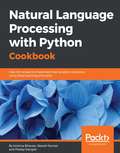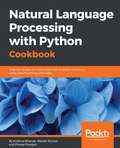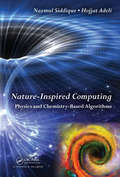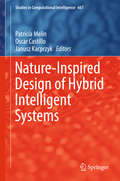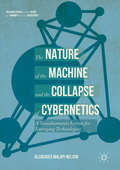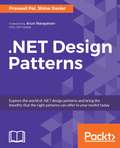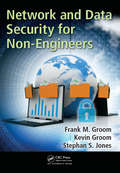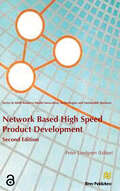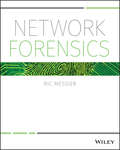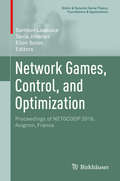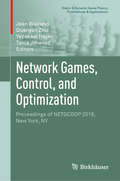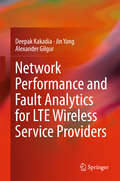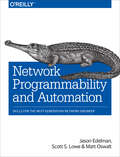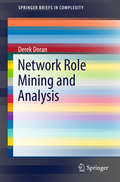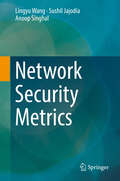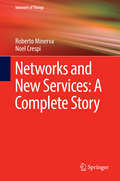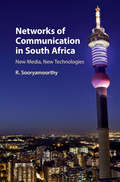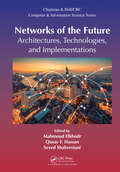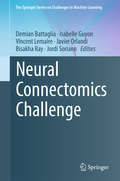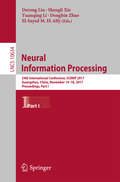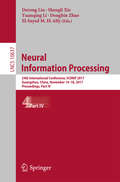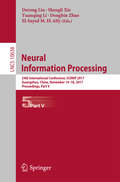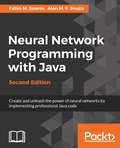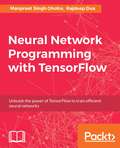- Table View
- List View
Natural Language Processing with Python Cookbook
by Pratap Dangeti Krishna Bhavsar Naresh KumarLearn the tricks and tips that will help you design Text Analytics solutions About This Book • Independent recipes that will teach you how to efficiently perform Natural Language Processing in Python • Use dictionaries to create your own named entities using this easy-to-follow guide • Learn how to implement NLTK for various scenarios with the help of example-rich recipes to take you beyond basic Natural Language Processing Who This Book Is For This book is intended for data scientists, data analysts, and data science professionals who want to upgrade their existing skills to implement advanced text analytics using NLP. Some basic knowledge of Natural Language Processing is recommended. What You Will Learn • Explore corpus management using internal and external corpora • Learn WordNet usage and a couple of simple application assignments using WordNet • Operate on raw text • Learn to perform tokenization, stemming, lemmatization, and spelling corrections, stop words removals, and more • Understand regular expressions for pattern matching • Learn to use and write your own POS taggers and grammars • Learn to evaluate your own trained models • Explore Deep Learning techniques in NLP • Generate Text from Nietzsche's writing using LSTM • Utilize the BABI dataset and LSTM to model episodes In Detail Natural Language Processing (NLP) is a field of computer science, artificial intelligence, and computational linguistics concerned with the interactions between computers and human (natural) languages; in particular, it's about programming computers to fruitfully process large natural language corpora. This book includes unique recipes that will teach you various aspects of performing Natural Language Processing with NLTK—the leading Python platform for the task. You will come across various recipes during the course, covering (among other topics) natural language understanding, Natural Language Processing, and syntactic analysis. You will learn how to understand language, plan sentences, and work around various ambiguities. You will learn how to efficiently use NLTK and implement text classification, identify parts of speech, tag words, and more. You will also learn how to analyze sentence structures and master lexical analysis, syntactic and semantic analysis, pragmatic analysis, and the application of deep learning techniques. By the end of this book, you will have all the knowledge you need to implement Natural Language Processing with Python. Style and Approach This book's rich collection of recipes will come in handy when you are working with Natural Language Processing with Python. Addressing your common and not-so-common pain points, this is a book that you must have on the shelf.
Natural Language Processing with Python Cookbook
by Krishna Bhavsar<P><P>Learn the tricks and tips that will help you design Text Analytics solutions <P><P>Key Features <P><P>Independent recipes that will teach you how to efficiently perform Natural Language Processing in Python <P><P>Use dictionaries to create your own named entities using this easy-to-follow guide <P><P>Learn how to implement NLTK for various scenarios with the help of example-rich recipes to take you beyond basic Natural Language Processing <P><P>Book Description <P><P>Natural Language Processing (NLP) is a field of computer science, artificial intelligence, and computational linguistics concerned with the interactions between computers and human (natural) languages; in particular, it's about programming computers to fruitfully process large natural language corpora. <P><P>This book includes unique recipes that will teach you various aspects of performing Natural Language Processing with NLTK the leading Python platform for the task. You will come across various recipes during the course, covering (among other topics) natural language understanding, Natural Language Processing, and syntactic analysis. You will learn how to understand language, plan sentences, and work around various ambiguities. You will learn how to efficiently use NLTK and implement text classification, identify parts of speech, tag words, and more. You will also learn how to analyze sentence structures and master lexical analysis, syntactic and semantic analysis, pragmatic analysis, and the application of deep learning techniques. <P><P>By the end of this book, you will have all the knowledge you need to implement Natural Language Processing with Python. <P><P>What You Will Learn <P><P>Explore corpus management using internal and external corpora <P><P>Learn WordNet usage and a couple of simple application assignments using WordNet <P><P>Operate on raw text <P><P>Learn to perform tokenization, stemming, lemmatization, and spelling corrections, stop words removals, and more <P><P>Understand regular expressions for pattern matching <P><P>Learn to use and write your own POS taggers and grammars <P><P>Learn to evaluate your own trained models <P><P>Explore Deep Learning techniques in NLP <P><P>Generate Text from Nietzsche's writing using LSTM <P><P>Utilize the BABI dataset and LSTM to model episodes
Nature-Inspired Computing: Physics and Chemistry-Based Algorithms
by Hojjat Adeli Nazmul H. SiddiqueNature-Inspired Computing: Physics and Chemistry-Based Algorithms provides a comprehensive introduction to the methodologies and algorithms in nature-inspired computing, with an emphasis on applications to real-life engineering problems. The research interest for Nature-inspired Computing has grown considerably exploring different phenomena observed in nature and basic principles of physics, chemistry, and biology. The discipline has reached a mature stage and the field has been well-established. This endeavour is another attempt at investigation into various computational schemes inspired from nature, which are presented in this book with the development of a suitable framework and industrial applications. Designed for senior undergraduates, postgraduates, research students, and professionals, the book is written at a comprehensible level for students who have some basic knowledge of calculus and differential equations, and some exposure to optimization theory. Due to the focus on search and optimization, the book is also appropriate for electrical, control, civil, industrial and manufacturing engineering, business, and economics students, as well as those in computer and information sciences. With the mathematical and programming references and applications in each chapter, the book is self-contained, and can also serve as a reference for researchers and scientists in the fields of system science, natural computing, and optimization.
Nature-Inspired Design of Hybrid Intelligent Systems
by Patricia Melin Oscar Castillo Janusz KacprzykThis book highlights recent advances in the design of hybrid intelligent systems based on nature-inspired optimization and their application in areas such as intelligent control and robotics, pattern recognition, time series prediction, and optimization of complex problems. The book is divided into seven main parts, the first of which addresses theoretical aspects of and new concepts and algorithms based on type-2 and intuitionistic fuzzy logic systems. The second part focuses on neural network theory, and explores the applications of neural networks in diverse areas, such as time series prediction and pattern recognition. The book's third part presents enhancements to meta-heuristics based on fuzzy logic techniques and describes new nature-inspired optimization algorithms that employ fuzzy dynamic adaptation of parameters, while the fourth part presents diverse applications of nature-inspired optimization algorithms. In turn, the fifth part investigates applications of fuzzy logic in diverse areas, such as time series prediction and pattern recognition. The sixth part examines new optimization algorithms and their applications. Lastly, the seventh part is dedicated to the design and application of different hybrid intelligent systems.
The Nature of the Machine and the Collapse of Cybernetics
by Alcibiades Malapi-NelsonThis book is a philosophical exploration of the theoretical causes behind the collapse of classical cybernetics, as well as the lesson that this episode can provide to current emergent technologies. Alcibiades Malapi-Nelson advances the idea that the cybernetic understanding of the nature of a machine entails ontological and epistemological consequences that created both material and theoretical conundrums. However, he proposes that given our current state of materials research, scientific practices, and research tools, there might be a way for cybernetics to flourish this time. The book starts with a historical and theoretical articulation of cybernetics in order to proceed with a philosophical explanation of its collapse--emphasizing the work of Alan Turing, Ross Ashby and John von Neumann. Subsequently, Malapi-Nelson unveils the common metaphysical signature shared between cybernetics and emergent technologies, identifying this signature as transhumanist in nature. Finally, avenues of research that may allow these disruptive technologies to circumvent the cybernetic fate are indicated. It is proposed that emerging technologies ultimately entail an affirmation of humanity.
Neon Genesis Evangelion: The Legend of Piko Piko Middle School Students Volume 2
by Yushi KawataShinji! Rei! Asuka! And of course...Kaworu! The elite four students of the National Defense Middle School...otherwise known as NERV! They're training to prevent the "New Century Apocalypse"...but will all their training help them when they're demoing dating sims on the main stage at Tokyo's largest game show? • Full of video game parodies--it's Evangelion meets Let's Play! • The most famous anime franchise of the last 20 years! • The latest anime movie, Neon Genesis Evangelion: 3.33 You Can (Not) Redo is available from Funimation. • Each volume contains four opening pages in full color.
.NET Design Patterns
by Shine Xavier Praseed PaiA practical and fast-paced guide that explores .NET design patternsAbout This BookThis book is based on the latest version of .NET, .NET Core 1.0.The code is explained piece by piece and the application of the pattern is also showcased.This fast-paced guide shows you how to implement the patterns into your existing applicationsWho This Book Is ForThis book is for those with familiarity with .NET development who would like to take their skills to the next level and be in the driver's seat when it comes to modern development techniques. Basic object-oriented C# programming experience and an elementary familiarity with the .NET framework library is required.What You Will LearnPut patterns and pattern catalogs into the right perspectiveApply patterns for software development under C#/.NETGOF and other patterns in real-life development scenariosHandle concurrency and parallelism using idioms under .NETLeverage Object/Functional programming by mixing OOP and FPUnderstand the Reactive Programming model using Rx and RxJsGet real-life insightsIn DetailKnowing about design patterns enables developers to improve their code base, promoting core reuse and making their architecture more robust.This book focuses on the practical aspects of coding in .NET. You will learn about all of the major design patterns, which will improve their functionality. We start with classic object-oriented programming (OOP) techniques, enhance implementations by mixing OOP and Functional Programming, and finally to the Reactive Programming model where Functional Programming and OOP are used in synergy to write better code.We'll focus on how to apply GOF patterns to solve real-life problems and improve the functionality of the software without changing the UI.Towards the end of this book, we'll show you how to deal with Architecture/Design techniques, GOF patterns, some patterns from other Catalogs, Functional Programming, and Reactive Programming techniques.After reading this book, you will be able to implement important design patterns for your programs, create major patterns viz. factory pattern, builder pattern, prototype patterns, adapter pattern, facade pattern, decorator pattern, etc.
Network and Data Security for Non-Engineers (Technology for Non-Engineers)
by Frank M. Groom Stephan S. Jones Kevin GroomLearn network and data security by analyzing the Anthem breach and step-by-step how hackers gain entry, place hidden software, download information, and hide the evidence of their entry. Understand the tools, establishing persistent presence, use of sites as testbeds to determine successful variations of software that elude detection, and reaching out across trusted connections to the entire healthcare system of the nation. Examine the components of technology being diverted, starting with application code and how to protect it with isolation approaches. Dissect forms of infections including viruses, worms, bots, and Trojans; and encryption with RSA algorithm as the working example.
Network Based High Speed Product Development
by Peter LindgrenIn the first decade of the 21st century product development in networks was predicted to be of ever-increasing importance to businesses of all sizes because of changes in markets, in technology, in networks, and in the competences of Businesses. The growth in new products’ share of businesses’ total turnover and earnings were increasing at an unprecedented speed. The entrepreneurial innovations and technological improvements had resulted in the increasingly fast development of new products and services. Businesses and industries in different countries became increasingly more linked and interdependent in networks with respect to materials, business operations and particularly product development to match the wants and needs of the global market environment to high speed product development. Businesses were therefore encountering increasingly dynamic market fragmentation, shrinking time in market, increasing product variety, demands of production to customer specifications, reduced product lifetimes, and globalization of production.Networks were vital because the competition is not business against business, but network against network. Networks are vital because an increasing part of product development was carried out in all types of networks containing physical, ICT, dynamic, and virtual networks. Speed and pressure on time in product development seemed to continue to increase because customer demands for new products seemed to continue to increase. However, a Business seldom possessed all needed competences, and managers saw product development based on networks as an important solution to meet the strong competition of the future global markets and the strong demand for innovation and innovativeness. The evolution of market demands and focus (required) on competencies of businesses could be characterized as a development from a focus on efficiency, to a focus on quality and flexibility, to a focus on speed and innovativeness.This was why it was interesting and important to research and discuss product development and especially to understand high speed product development of individualized products in fragile market segments. Consequently, findings and learning on aspects like enablers, management tools, technological tools, product development models, product development processes and network tools to speed new product development are presented in this book.
Network Forensics
by Ric MessierIntensively hands-on training for real-world network forensics Network Forensics provides a uniquely practical guide for IT and law enforcement professionals seeking a deeper understanding of cybersecurity. This book is hands-on all the way—by dissecting packets, you gain fundamental knowledge that only comes from experience. Real packet captures and log files demonstrate network traffic investigation, and the learn-by-doing approach relates the essential skills that traditional forensics investigators may not have. From network packet analysis to host artifacts to log analysis and beyond, this book emphasizes the critical techniques that bring evidence to light. Network forensics is a growing field, and is becoming increasingly central to law enforcement as cybercrime becomes more and more sophisticated. This book provides an unprecedented level of hands-on training to give investigators the skills they need. Investigate packet captures to examine network communications Locate host-based artifacts and analyze network logs Understand intrusion detection systems—and let them do the legwork Have the right architecture and systems in place ahead of an incident Network data is always changing, and is never saved in one place; an investigator must understand how to examine data over time, which involves specialized skills that go above and beyond memory, mobile, or data forensics. Whether you're preparing for a security certification or just seeking deeper training for a law enforcement or IT role, you can only learn so much from concept; to thoroughly understand something, you need to do it. Network Forensics provides intensive hands-on practice with direct translation to real-world application.
Network Games, Control, and Optimization
by Samson Lasaulce Tania Jimenez Eilon SolanThis contributed volume offers a collection of papers presented at the 2016 Network Games, Control, and Optimization conference (NETGCOOP), held at the University of Avignon in France, November 23-25, 2016. These papers highlight the increasing importance of network control and optimization in many networking application domains, such as mobile and fixed access networks, computer networks, social networks, transportation networks, and, more recently, electricity grids and biological networks. Covering a wide variety of both theoretical and applied topics in the areas listed above, the authors explore several conceptual and algorithmic tools that are needed for efficient and robust control operation, performance optimization, and better understanding the relationships between entities that may be acting cooperatively or selfishly in uncertain and possibly adversarial environments. As such, this volume will be of interest to applied mathematicians, computer scientists, engineers, and researchers in other related fields.
Network Games, Control, and Optimization: Proceedings Of Netgcoop 2016, Avignon, France (Static & Dynamic Game Theory: Foundations & Applications)
by Jean Walrand Quanyan Zhu Yezekael Hayel Tania JimenezThis contributed volume offers a collection of papers presented at the 2016 Network Games, Control, and Optimization conference (NETGCOOP), held at the University of Avignon in France, November 23-25, 2016. These papers highlight the increasing importance of network control and optimization in many networking application domains, such as mobile and fixed access networks, computer networks, social networks, transportation networks, and, more recently, electricity grids and biological networks. Covering a wide variety of both theoretical and applied topics in the areas listed above, the authors explore several conceptual and algorithmic tools that are needed for efficient and robust control operation, performance optimization, and better understanding the relationships between entities that may be acting cooperatively or selfishly in uncertain and possibly adversarial environments. As such, this volume will be of interest to applied mathematicians, computer scientists, engineers, and researchers in other related fields.
Network Performance and Fault Analytics for LTE Wireless Service Providers
by Deepak Kakadia Jin Yang Alexander GilgurThis book is intended to describe how to leverage emerging technologies big data analytics and SDN, to address challenges specific to LTE and IP network performance and fault management data in order to more efficiently manage and operate an LTE wireless networks. The proposed integrated solutions permit the LTE network service provider to operate entire integrated network, from RAN to Core , from UE to application service, as one unified system and correspondingly collect and align disparate key metrics and data, using an integrated and holistic approach to network analysis. The LTE wireless network performance and fault involves the network performance and management of network elements in EUTRAN, EPC and IP transport components, not only as individual components, but also as nuances of inter-working of these components. The key metrics for EUTRAN include radio access network accessibility, retainability, integrity, availability and mobility. The key metrics for EPC include MME accessibility, mobility and capacity, SGW, PGW capacity and connectivity. In the first parts of the book, the authors describe fundamental analytics techniques, and various key network partitions - RAN, Backhaul, Metro and Core of a typical LTE Wireless Service Provider Network. The second part of the book develops more advanced analytic techniques that can be used to solve complex wireless network problems. The second part of this book also describes practical and novel solutions for LTE service network performance and fault management systems using big data engineering. Self-organizing network (SON) architecture is presented as a way to utilize network performance and fault analytics to enable network automation. SON can significantly improve operational efficiencies and speed up network deployment. This book provides various ways to leverage data science to more intelligently and reliably to automate and manage a wireless network. The contents of the book should be useful to professional engineers and networking experts involved in LTE network operations and management. The content will also be of interest to researchers, academic and corporate, interested in the developments in fault analytics in LTE networks.
Network Programmability and Automation: Skills for the Next-Generation Network Engineer
by Jason Edelman Scott S. Lowe Matt OswaltLike sysadmins before them, network engineers are finding that they cannot do their work manually anymore. As the field faces new protocols, technologies, delivery models, and a pressing need for businesses to be more agile and flexible, network automation is becoming essential. This practical guide shows network engineers how to use a range of technologies and tools—including Linux, Python, JSON, and XML—to automate their systems through code.Network programming and automation will help you simplify tasks involved in configuring, managing, and operating network equipment, topologies, services, and connectivity. Through the course of the book, you’ll learn the basic skills and tools you need to make this critical transition.This book covers:Python programming basics: data types, conditionals, loops, functions, classes, and modulesLinux fundamentals to provide the foundation you need on your network automation journeyData formats and models: JSON, XML, YAML, and YANG for networkingJinja templating and its applicability for creating network device configurationsThe role of application programming interfaces (APIs) in network automationSource control with Git to manage code changes during the automation processHow Ansible, Salt, and StackStorm open source automation tools can be used to automate network devicesKey tools and technologies required for a Continuous Integration (CI) pipeline in network operations
Network Role Mining and Analysis
by Derek DoranThis brief presents readers with a summary of classic, modern, and state-of-the-art methods for discovering the roles of entities in networks (including social networks) that range from small to large-scale. It classifies methods by their mathematical underpinning, whether they are driven by implications about entity behaviors in system, or if they are purely data driven. The brief also discusses when and how each method should be applied, and discusses some outstanding challenges toward the development of future role mining methods of each type.
Network Security Metrics
by Lingyu Wang Sushil Jajodia Anoop SinghalThis book examines different aspects of network security metrics and their application to enterprise networks. One of the most pertinent issues in securing mission-critical computing networks is the lack of effective security metrics which this book discusses in detail. Since "you cannot improve what you cannot measure", a network security metric is essential to evaluating the relative effectiveness of potential network security solutions. The authors start by examining the limitations of existing solutions and standards on security metrics, such as CVSS and attack surface, which typically focus on known vulnerabilities in individual software products or systems. The first few chapters of this book describe different approaches to fusing individual metric values obtained from CVSS scores into an overall measure of network security using attack graphs. Since CVSS scores are only available for previously known vulnerabilities, such approaches do not consider the threat of unknown attacks exploiting the so-called zero day vulnerabilities. Therefore, several chapters of this book are dedicated to develop network security metrics especially designed for dealing with zero day attacks where the challenge is that little or no prior knowledge is available about the exploited vulnerabilities, and thus most existing methodologies for designing security metrics are no longer effective. Finally, the authors examine several issues on the application of network security metrics at the enterprise level. Specifically, a chapter presents a suite of security metrics organized along several dimensions for measuring and visualizing different aspects of the enterprise cyber security risk, and the last chapter presents a novel metric for measuring the operational effectiveness of the cyber security operations center (CSOC). Security researchers who work on network security or security analytics related areas seeking new research topics, as well as security practitioners including network administrators and security architects who are looking for state of the art approaches to hardening their networks, will find this book helpful as a reference. Advanced-level students studying computer science and engineering will find this book useful as a secondary text.
Networks and New Services: A Complete Story
by Roberto Minerva Noel CrespiThis book shines a spotlight on software-centric networks and their emerging service environments. The authors examine the road ahead for connectivity, for both humans and 'things', considering the rapid changes that have shaken the industry. The book analyses major catalytic shifts that are shaping the communications world: softwarization, virtualization, and cloud computing. It guides the reader through a maze of possible architectural choices, driven by discriminating and sometimes conflicting business considerations. The new ICT capabilities lead us toward smarter environments and to an ecosystem where applications are backed up by shared networking facilities, instead of networks that support their own applications. Growing user awareness is a key driver towards the softwarization process. Softwarization disrupts the current status quo for equipment, development, networks, operations and business. It changes radically the value chain and the involved stakeholders. The dilemma is between a 'slow burn' traditional step-by-step approach and a bold transformation of the whole infrastructure and business models. This book is essential reading for those seeking to build user-centric communication networks that support independent agile and smart applications. "The book gives an insightful account of modern telecom networks, pinpointing the radical transformations of the last 20 years. This is the perfect read for those who are interested in the grand challenges of networks and in the socio-economic reasons why the telecom industry to embrace the Internet of Things and cyber-physical systems. " Prof. Antonio Liotta, Eindhoven University of Technology "This book fulfills an urgent need to thoroughly analyze the entanglement of network and software architectures by taking into account the increasing softwarization. It highlights important issues behind today's business models and opens the road for sustainable future approaches to provide user appreciated valuable services. " Dr. Eng. Hendrik Berndt, former CTO of NTT DOCOMO Communications Laboratories Europe
Networks of Communication in South Africa: New Media, New Technologies
by R. SooryamoorthyWithin a short period of time, South Africa has made remarkable progress in the adoption of mobile and Internet technologies. In this landmark study, R. Sooryamoorthy examines the development of communication patterns, social contacts and networks in South Africa. Based on pioneering quantitative and qualitative data, he analyses trends in changing media use in Africa, showing the development of the use of new media for communication by South Africans of all ages, races and genders in relation to the development of media infrastructure, its cost and government policy. It shows how people use the media for communication purposes that affirm or break their social contacts and networks, and how they apply media to establish, re-establish or maintain social relationships. This book will be of interest to those researching the growth of communication technology in Africa, as well as those involved in the wider fields of development studies and economics.
Networks of the Future: Architectures, Technologies, and Implementations (Chapman & Hall/CRC Computer and Information Science Series)
by Seyed Shahrestani Qusay F. Hassan Mahmoud ElkhodrWith the ubiquitous diffusion of the IoT, Cloud Computing, 5G and other evolved wireless technologies into our daily lives, the world will see the Internet of the future expand ever more quickly. Driving the progress of communications and connectivity are mobile and wireless technologies, including traditional WLANs technologies and low, ultra-power, short and long-range technologies. These technologies facilitate the communication among the growing number of connected devices, leading to the generation of huge volumes of data. Processing and analysis of such "big data" brings about many opportunities, as well as many challenges, such as those relating to efficient power consumptions, security, privacy, management, and quality of service. This book is about the technologies, opportunities and challenges that can drive and shape the networks of the future. Written by established international researchers and experts, Networks of the Future answers fundamental and pressing research challenges in the field, including architectural shifts, concepts, mitigation solutions and techniques, and key technologies in the areas of networking. The book starts with a discussion on Cognitive Radio (CR) technologies as promising solutions for improving spectrum utilization, and also highlights the advances in CR spectrum sensing techniques and resource management methods. The second part of the book presents the latest developments and research in the areas of 5G technologies and Software Defined Networks (SDN). Solutions to the most pressing challenges facing the adoption of 5G technologies are also covered, and the new paradigm known as Fog Computing is examined in the context of 5G networks. The focus next shifts to efficient solutions for future heterogeneous networks. It consists of a collection of chapters that discuss self-healing solutions, dealing with Network Virtualization, QoS in heterogeneous networks, and energy efficient techniques for Passive Optical Networks and Wireless Sensor Networks. Finally, the areas of IoT and Big Data are discussed, including the latest developments and future perspectives of Big Data and the IoT paradigms.
Neural Connectomics Challenge
by Demian Battaglia Isabelle Guyon Vincent Lemaire Javier Orlandi Bisakha Ray Jordi SorianoThis book illustrates the thrust of the scientific community to use machine learning concepts for tackling a complex problem: given time series of neuronal spontaneous activity, which is the underlying connectivity between the neurons in the network? The contributing authors also develop tools for the advancement of neuroscience through machine learning techniques, with a focus on the major open problems in neuroscience. While the techniques have been developed for a specific application, they address the more general problem of network reconstruction from observational time series, a problem of interest in a wide variety of domains, including econometrics, epidemiology, and climatology, to cite only a few. The book is designed for the mathematics, physics and computer science communities that carry out research in neuroscience problems. The content is also suitable for the machine learning community because it exemplifies how to approach the same problem from different perspectives.
Neural Information Processing: 24th International Conference, ICONIP 2017, Guangzhou, China, November 14-18, 2017, Proceedings, Part I (Lecture Notes in Computer Science #10634)
by Derong Liu, Shengli Xie, Yuanqing Li, Dongbin Zhao and El-Sayed M. El-AlfyThe six volume set LNCS 10634, LNCS 10635, LNCS 10636, LNCS 10637, LNCS 10638, and LNCS 10639 constitues the proceedings of the 24rd International Conference on Neural Information Processing, ICONIP 2017, held in Guangzhou, China, in November 2017. The 563 full papers presented were carefully reviewed and selected from 856 submissions. The 6 volumes are organized in topical sections on Machine Learning, Reinforcement Learning, Big Data Analysis, Deep Learning, Brain-Computer Interface, Computational Finance, Computer Vision, Neurodynamics, Sensory Perception and Decision Making, Computational Intelligence, Neural Data Analysis, Biomedical Engineering, Emotion and Bayesian Networks, Data Mining, Time-Series Analysis, Social Networks, Bioinformatics, Information Security and Social Cognition, Robotics and Control, Pattern Recognition, Neuromorphic Hardware and Speech Processing.
Neural Information Processing: 24th International Conference, ICONIP 2017, Guangzhou, China, November 14–18, 2017, Proceedings, Part IV (Lecture Notes in Computer Science #10637)
by Derong Liu, Shengli Xie, Yuanqing Li, Dongbin Zhao and El-Sayed M. El-AlfyThe six volume set LNCS 10634, LNCS 10635, LNCS 10636, LNCS 10637, LNCS 10638, and LNCS 10639 constitues the proceedings of the 24rd International Conference on Neural Information Processing, ICONIP 2017, held in Guangzhou, China, in November 2017. The 563 full papers presented were carefully reviewed and selected from 856 submissions. The 6 volumes are organized in topical sections on Machine Learning, Reinforcement Learning, Big Data Analysis, Deep Learning, Brain-Computer Interface, Computational Finance, Computer Vision, Neurodynamics, Sensory Perception and Decision Making, Computational Intelligence, Neural Data Analysis, Biomedical Engineering, Emotion and Bayesian Networks, Data Mining, Time-Series Analysis, Social Networks, Bioinformatics, Information Security and Social Cognition, Robotics and Control, Pattern Recognition, Neuromorphic Hardware and Speech Processing.
Neural Information Processing: 24th International Conference, ICONIP 2017, Guangzhou, China, November 14–18, 2017, Proceedings, Part V (Lecture Notes in Computer Science #10638)
by Derong Liu Shengli Xie Yuanqing Li Dongbin Zhao El-Sayed M. El-AlfyThe six volume set LNCS 10634, LNCS 10635, LNCS 10636, LNCS 10637, LNCS 10638, and LNCS 10639 constitues the proceedings of the 24rd International Conference on Neural Information Processing, ICONIP 2017, held in Guangzhou, China, in November 2017. The 563 full papers presented were carefully reviewed and selected from 856 submissions. The 6 volumes are organized in topical sections on Machine Learning, Reinforcement Learning, Big Data Analysis, Deep Learning, Brain-Computer Interface, Computational Finance, Computer Vision, Neurodynamics, Sensory Perception and Decision Making, Computational Intelligence, Neural Data Analysis, Biomedical Engineering, Emotion and Bayesian Networks, Data Mining, Time-Series Analysis, Social Networks, Bioinformatics, Information Security and Social Cognition, Robotics and Control, Pattern Recognition, Neuromorphic Hardware and Speech Processing.
Neural Network Programming with Java - Second Edition
by Fabio M. Soares Alan M. SouzaCreate and unleash the power of neural networks by implementing professional Java code About This Book • Learn to build amazing projects using neural networks including forecasting the weather and pattern recognition • Explore the Java multi-platform feature to run your personal neural networks everywhere • This step-by-step guide will help you solve real-world problems and links neural network theory to their application Who This Book Is For This book is for Java developers who want to know how to develop smarter applications using the power of neural networks. Those who deal with a lot of complex data and want to use it efficiently in their day-to-day apps will find this book quite useful. Some basic experience with statistical computations is expected. What You Will Learn • Develop an understanding of neural networks and how they can be fitted • Explore the learning process of neural networks • Build neural network applications with Java using hands-on examples • Discover the power of neural network's unsupervised learning process to extract the intrinsic knowledge hidden behind the data • Apply the code generated in practical examples, including weather forecasting and pattern recognition • Understand how to make the best choice of learning parameters to ensure you have a more effective application • Select and split data sets into training, test, and validation, and explore validation strategies In Detail Want to discover the current state-of-art in the field of neural networks that will let you understand and design new strategies to apply to more complex problems? This book takes you on a complete walkthrough of the process of developing basic to advanced practical examples based on neural networks with Java, giving you everything you need to stand out. You will first learn the basics of neural networks and their process of learning. We then focus on what Perceptrons are and their features. Next, you will implement self-organizing maps using practical examples. Further on, you will learn about some of the applications that are presented in this book such as weather forecasting, disease diagnosis, customer profiling, generalization, extreme machine learning, and characters recognition (OCR). Finally, you will learn methods to optimize and adapt neural networks in real time. All the examples generated in the book are provided in the form of illustrative source code, which merges object-oriented programming (OOP) concepts and neural network features to enhance your learning experience. Style and approach This book takes you on a steady learning curve, teaching you the important concepts while being rich in examples. You'll be able to relate to the examples in the book while implementing neural networks in your day-to-day applications.
Neural Network Programming with TensorFlow: Unleash the power of TensorFlow to train efficient neural networks
by Rajdeep Dua Manpreet Singh GhotraNeural Networks and their implementation decoded with TensorFlow About This Book • Develop a strong background in neural network programming from scratch, using the popular Tensorflow library. • Use Tensorflow to implement different kinds of neural networks – from simple feedforward neural networks to multilayered perceptrons, CNNs, RNNs and more. • A highly practical guide including real-world datasets and use-cases to simplify your understanding of neural networks and their implementation. Who This Book Is For This book is meant for developers with a statistical background who want to work with neural networks. Though we will be using TensorFlow as the underlying library for neural networks, book can be used as a generic resource to bridge the gap between the math and the implementation of deep learning. If you have some understanding of Tensorflow and Python and want to learn what happens at a level lower than the plain API syntax, this book is for you. What You Will Learn • Learn Linear Algebra and mathematics behind neural network. • Dive deep into Neural networks from the basic to advanced concepts like CNN, RNN Deep Belief Networks, Deep Feedforward Networks. • Explore Optimization techniques for solving problems like Local minima, Global minima, Saddle points • Learn through real world examples like Sentiment Analysis. • Train different types of generative models and explore autoencoders. • Explore TensorFlow as an example of deep learning implementation. In Detail If you're aware of the buzz surrounding the terms such as "machine learning," "artificial intelligence," or "deep learning," you might know what neural networks are. Ever wondered how they help in solving complex computational problem efficiently, or how to train efficient neural networks? This book will teach you just that. You will start by getting a quick overview of the popular TensorFlow library and how it is used to train different neural networks. You will get a thorough understanding of the fundamentals and basic math for neural networks and why TensorFlow is a popular choice Then, you will proceed to implement a simple feed forward neural network. Next you will master optimization techniques and algorithms for neural networks using TensorFlow. Further, you will learn to implement some more complex types of neural networks such as convolutional neural networks, recurrent neural networks, and Deep Belief Networks. In the course of the book, you will be working on real-world datasets to get a hands-on understanding of neural network programming. You will also get to train generative models and will learn the applications of autoencoders. By the end of this book, you will have a fair understanding of how you can leverage the power of TensorFlow to train neural networks of varying complexities, without any hassle. While you are learning about various neural network implementations you will learn the underlying mathematics and linear algebra and how they map to the appropriate TensorFlow constructs. Style and Approach This book is designed to give you just the right number of concepts to back up the examples. With real-world use cases and problems solved, this book is a handy guide for you. Each concept is backed by a generic and real-world problem, followed by a variation, making you independent and able to solve any problem with neural networks. All of the content is demystified by a simple and straightforward approach.
